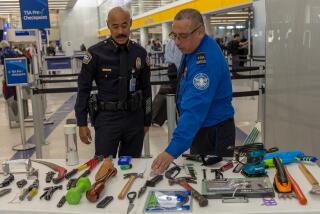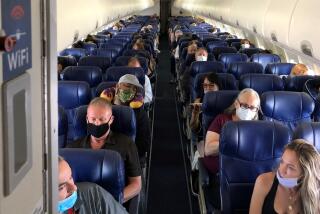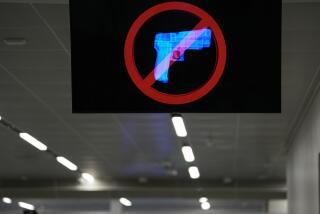Airports Fail to Scan Baggage, Official Says
- Share via
WASHINGTON — Even under heightened security after the Sept. 11 terrorist attacks, scores of machines to detect bombs in checked baggage at U.S. airports are idle or underused, a federal investigator told Congress on Thursday.
The testimony from Kenneth Mead, inspector general at the Transportation Department, provided a rare independent critique of one aspect of the Federal Aviation Administration’s security crackdown. Although armed troops and long lines at airports attest to a greater concern with safety, many experts doubt that all loopholes have been closed.
“Bulk explosives detection systems continue to be seriously underutilized,” Mead told the House aviation subcommittee. The $1-million machines work on the same principle as CT scanners used in medical diagnosis.
Other witnesses told the panel that more advanced technology is available--including body scanners and machines that detect the scent of explosives--but that the FAA has been slow to embrace it.
Mead said his agents recently checked seven major airports and found some bomb-detection machines turned off and others staffed but not in use despite an FAA order after the attacks that the units be operated continuously.
Terrorists have planted bombs in checked baggage before, with devastating effect. In 1988, Pan Am Flight 103 was brought down over Lockerbie, Scotland, by a bomb hidden in a bag in the cargo hold. All 259 people aboard the Boeing 747 were killed, as were 11 people on the ground.
Mead estimated that at U.S. airports, bomb-detection machines are being used at less than 10% of capacity. Equipment capable of screening 150 bags an hour instead scans an average of 350 bags a day, he said. His estimate was based on figures from July, the latest available.
About 140 of the scanners are being used by airlines at about 50 major airports around the country. An additional 20 or so of the devices are in a warehouse, Mead said.
The FAA pays for the detection equipment and its installation. However, airlines have complained that heavy utilization could lead to delays.
Michael Wascom, a spokesman for the Air Transport Assn., which represents major airlines, questioned the inspector general’s conclusions.
“Mr. Mead went to seven airports,” he said. “The airlines are doing what we have been told, as per the FAA. I have every reason to believe that all our members are complying with this directive.”
Before Sept. 11, use of the scanning machines was limited. The bags of passengers flagged by a computerized profiling program were checked, as were a small, random sample of other bags.
Since Sept. 11, the FAA has directed airlines to increase the number of bags scanned at random. But Mead said the FAA’s order was too fuzzy.
FAA Administrator Jane Garvey said she agrees that the scanners are generally underused, and she said the agency is taking steps to enforce its order that they be used continuously. She also told the committee that machines now warehoused will be deployed within 90 days.
Lawmakers at the hearing said they were frustrated with the FAA, but some also said Congress shares blame for allowing the airline industry to put convenience and cost ahead of security. Rep. Peter A. DeFazio (D-Ore.), said the current system represents “security on the cheap.”
“This is not just a failure of government,” DeFazio said. “This is a failure of government because government responds to pressure and influence.”
More to Read
Sign up for Essential California
The most important California stories and recommendations in your inbox every morning.
You may occasionally receive promotional content from the Los Angeles Times.










